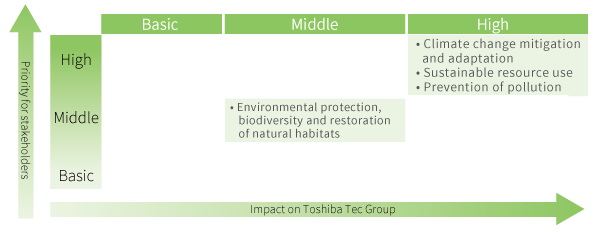Risks and Opportunities
Priority issues (Materiality issues)
Toshiba Tec Group as a member of Toshiba Group has set three high priority responsibilities (Materiality). In reference to opinions from stakeholders as well as assessment reviews by third-party organizations and including self-evaluations conducted based on the international guidance standard ISO 26000 which concerns the social responsibilities of organizations, we evaluated these responsibilities in terms of material issues for both Toshiba Tec Group and its stakeholders, and identified the following three high priority responsibilities. One of them is "Environmental Management," and among various environmental issues, we have chosen the following three items having both risks and opportunities with relatively high priority responsibilities: "Climate change mitigation and adaptation," "Sustainable resource use," and "Prevention of pollution."
Significance of Environment-related Items in Toshiba Tec Group's High Priority Responsibilities

We consider "Climate change mitigation and adaptation" to have significant impacts on business activities due to the magnitude and scale of their influence. According to IPCC*, to achieve a figure below the climate target of 2°C, the accumulated CO2 emissions must be below 800 GtC. It was also pointed out that if the current level of emissions continues, the accumulated emissions will exceed the acceptable limit within 20 to 30 years. It is also anticipated that unusual weather will occur more frequently so there will be greater corresponding fluctuations in weather patterns. Our efforts for significantly reducing GHG emissions toward achieving a de-carbonized society involve making a drastic change in our efforts for significantly reducing GHG emissions in our social system while still feeling very uncertain of what steps to take, which also holds true for the rapid surfacing of impacts from rising temperatures and climate change. It is absolutely essential that we recognize the risks and opportunities involved in such a drastic change and incorporate them into our future corporate management.
"Sustainable resource use" is associated with risks, such as introduction of laws and regulations regarding resource efficiency as well as energy efficiency, resource price hikes, and procurement. While reducing costs by improving resource efficiency, we will lower our dependency on resources through reuse and recycling.
In regard to "Prevention of pollution," we will ensure that chemicals contained in products are managed with the aim of minimizing the risk from the chemical substance. Since various related laws and regulations are being fully implemented on a global basis, we will prevent the risk of business suspensions due to delays in compliance by ensuring information transmission along the supply chain.
With the aim of achieving Environmental Vision 2050, Toshiba Tec Group as a member of Toshiba Group will continue to take initiatives mainly for these high priority responsibilities.
* Intergovernmental Panel on Climate Change
Climate Change Risks and Opportunities
Climate change risks and opportunities are important management issues and multiple KPIs are included in the action plan for 2023 (the Seventh Environmental Action Plan) as responses to climate change. For greenhouse gas management, we set KPIs in terms of both Business processes and Products and services by taking into account that in addition to compliance with policies such as carbon tax and energy-saving regulations, companies' commitment to climate change will affect their environmental brands and even selection of their products and services by customers.
Greenhouse gas management by business processes is effective in reducing transition risks in the course of future enhancement of regulations (for example, future introduction or enhancement of a carbon tax system).In addition, we consider increasing our competitiveness by improving productivity while reducing transition risks.
For products and services, the enhancement of energy-saving regulations poses risks. However, we have been monitoring and evaluating global trends of environmental laws and regulations by using industrial associations and external services. In addition, we will increase our offerings of products and services having high energy efficiency so that opportunities such as expanding energy-saving markets in regions can be optimized.
Corporate Data
-
- Topics
- CEO Message
- Message from Chief Sustainability Officer
- Toshiba Tec Group Sustainability Policy and Materiality KPI
- Special Feature SDGs x Toshiba Tec
- SDGs of Toshiba Tec
- Environment
- Social
- Governance
- Feature: 5-Minute Guide—Toshiba Tec CSR Activities
- Integrated Report














